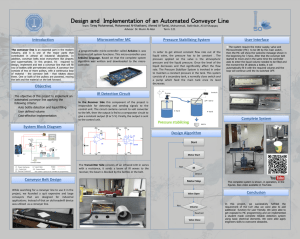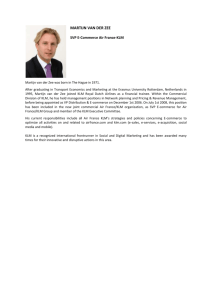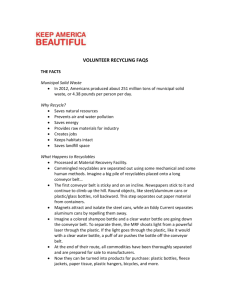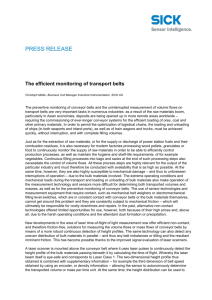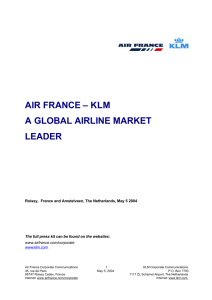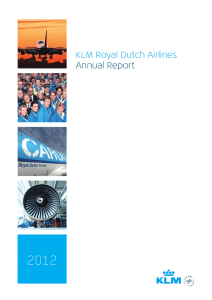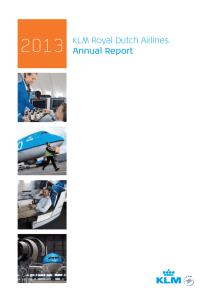Report of the Greater Manchester/Lancashire/PHLS Liaison Group
advertisement
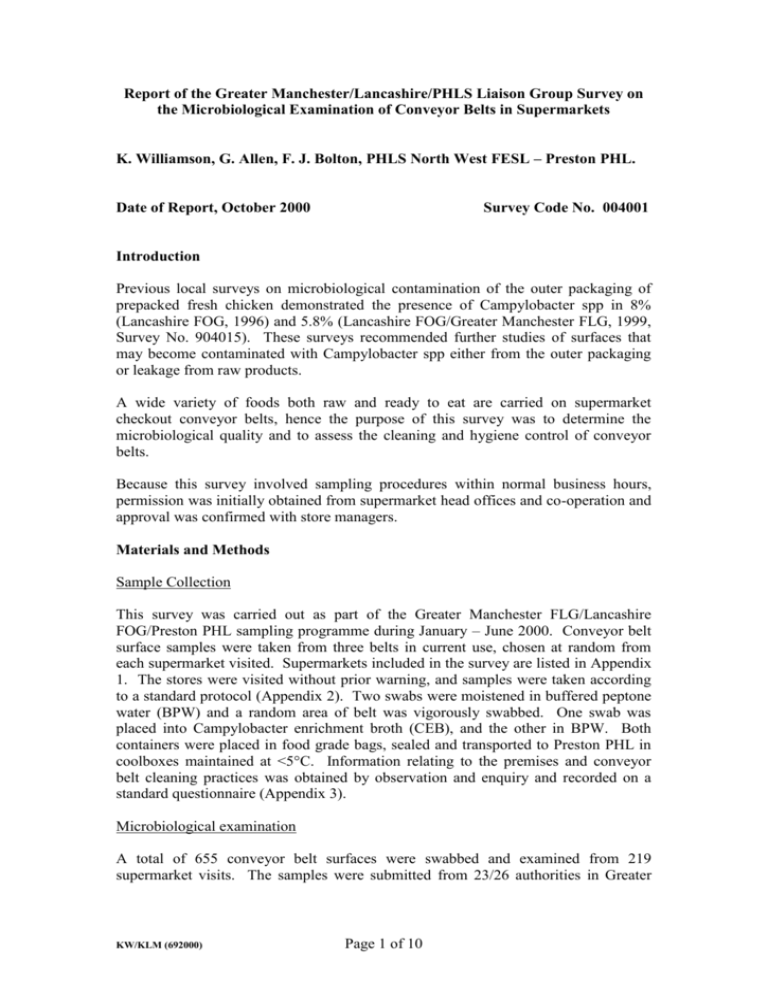
Report of the Greater Manchester/Lancashire/PHLS Liaison Group Survey on the Microbiological Examination of Conveyor Belts in Supermarkets K. Williamson, G. Allen, F. J. Bolton, PHLS North West FESL – Preston PHL. Date of Report, October 2000 Survey Code No. 004001 Introduction Previous local surveys on microbiological contamination of the outer packaging of prepacked fresh chicken demonstrated the presence of Campylobacter spp in 8% (Lancashire FOG, 1996) and 5.8% (Lancashire FOG/Greater Manchester FLG, 1999, Survey No. 904015). These surveys recommended further studies of surfaces that may become contaminated with Campylobacter spp either from the outer packaging or leakage from raw products. A wide variety of foods both raw and ready to eat are carried on supermarket checkout conveyor belts, hence the purpose of this survey was to determine the microbiological quality and to assess the cleaning and hygiene control of conveyor belts. Because this survey involved sampling procedures within normal business hours, permission was initially obtained from supermarket head offices and co-operation and approval was confirmed with store managers. Materials and Methods Sample Collection This survey was carried out as part of the Greater Manchester FLG/Lancashire FOG/Preston PHL sampling programme during January – June 2000. Conveyor belt surface samples were taken from three belts in current use, chosen at random from each supermarket visited. Supermarkets included in the survey are listed in Appendix 1. The stores were visited without prior warning, and samples were taken according to a standard protocol (Appendix 2). Two swabs were moistened in buffered peptone water (BPW) and a random area of belt was vigorously swabbed. One swab was placed into Campylobacter enrichment broth (CEB), and the other in BPW. Both containers were placed in food grade bags, sealed and transported to Preston PHL in coolboxes maintained at <5°C. Information relating to the premises and conveyor belt cleaning practices was obtained by observation and enquiry and recorded on a standard questionnaire (Appendix 3). Microbiological examination A total of 655 conveyor belt surfaces were swabbed and examined from 219 supermarket visits. The samples were submitted from 23/26 authorities in Greater KW/KLM (692000) Page 1 of 10 Manchester and Lancashire as detailed in Appendix 4, and examined for the presence of Salmonella and Campylobacter and enumeration of E. coli. Results Microbiological results Table 1. Microbiological results of conveyor belt surfaces (n = 655) Detected/sample E. coli Salmonella Campylobacter Not detected/sample <40cfu/sample 655 0 0 655 655 Questionnaire results Questionnaire results are listed below but were not analysed in relation to microbiological quality due to all results being satisfactory. Q.1. How many checkouts are there? (n = 219) 1-5 75 (34%) Q.2. 11-15 28 (13%) 16-20 15 (7%) >20 40 (18%) Are bags available to the customer at point of fresh raw meat/poultry display? (n = 180) Yes 73 (41%) Q.3. 6-10 61 (28%) No 107 (59%) Appearance of belts at checkouts: Checkout A(n=214) B(n=214) C(n=214) Total (n=642) KW/KLM (692000) Clean 181 (85%) 175 (82%) 168 (79%) 524 (82%) Page 2 of 10 Wet 3 (1%) 5 (2%) 5 (2%) 13 (2%) Soiled 30 (14%) 34 (16%) 41 (19%) 105 (16%) Q.4. Who cleans the belts? (n=219) Contract cleaners 37 (17%) Q.5. Once per day 173 (80%) Twice per day 20 (9%) Other 24 (11%) Are the belts cleaned immediately if the belt appears: Wet (n=211) Soiled (n=207) Breakage/spill (n=211) Q.7. Both 29 (13%) How often are the belts cleaned? (n=217) Never 0 Q.6. Supermarket staff 153 (70%) Yes 208 (99%) 202 (98%) 210 (99.5%) No 2 (1%) 5 (2%) 1 (0.5%) Are cleaning materials available at: (n=214) Every checkout Every other checkout Other* Other 54 (25%) 20 (9%) 140 (65%) 114 (53%) * NB. The majority were readily available from a storeroom or cleaners room Q.8. What cleaning agent is used (n=197) Detergent 60 (30%) Q.9. Sanitiser 97 (49%) Detergent/disinfectant 24 (12%) Disinfectant 9 (5%) Window cleaner 7 (4%) How is the cleaning agent stored at the point of use? (n=191) Spray 138 (72%) Container 37 (19%) Wipe 16 (8%) Q.10. How often is the cleaning cloth disposed? (n=213) Each time used 133 (62%) KW/KLM (692000) Daily 40 (19%) >Daily 24 (11%) Page 3 of 10 Not known 16 (8%) Conclusions (1) In relation to the indicator and pathogen organisms investigated, the microbiological quality of conveyor belt surfaces was considered excellent. There was no evidence of transfer and/or survival of Salmonella, Campylobacter or E. coli on the belt surface. (2) The results of the questionnaire indicated good hygiene practices associated with conveyor belt cleaning e.g. frequency, appearance, spillage, etc. (3) The potential for cross contamination from the outer packaging of raw poultry has been established (Survey No. 904015). Leakage from raw products particularly frozen poultry on thawing (Survey 004006) may also be a potential source of pathogen transfer. Hence the provision of bags at raw meat/poultry display for customer use is considered good practice and recommended. However the provision of bags was only observed, during 73/180 (41%) of supermarket visits. Future work Further surveys relating to potential sources of Campylobacter in retail outlets. Future sampling points need to be identified for investigation i.e. shopping trolleys/baskets, shelving. Acknowledgements The authors would like to thank Alan Walker (Preston) and particularly Kathryn Beryl (Oldham) for their assistance in producing the questionnaire and protocol, and for their support and advice. KW/KLM (692000) Page 4 of 10 APPENDIX 1 LIST OF PARTICIPATING SUPERMARKETS: - Co-operative Retail Services Ltd United Norwest Co-operative Ltd Somerfield Stores Ltd Safeway Stores PLC Iceland Frozen Foods PLC Aldi Stores Tesco Stores Ltd Marks and Spencer PLC Lidl UK Wm. Morrisons Supermarkets PLC Sainsbury’s Supermarkets Ltd KW/KLM (692000) Page 5 of 10 APPENDIX 2 KW/KLM (692000) Page 6 of 10 KW/KLM (692000) Page 7 of 10 KW/KLM (692000) Page 8 of 10 APPENDIX 3 KW/KLM (692000) Page 9 of 10 APPENDIX 4 A total of 655 samples were received from 23 out of the 26 authorities in Greater Manchester and Lancashire Authority Number of supermarket visits Number of samples received Barrow Blackburn Blackpool Bolton Burnley Bury Chorley Fylde Hyndburn Lancaster Manchester Oldham Pendle Preston Ribble Valley Rochdale Rossendale Salford South Lakes South Ribble Stockport Tameside Trafford West Lancs Wigan Wyre 0 0 11 10 12 13 12 12 5 6 10 10 0 14 5 8 8 12 4 4 6 12 11 12 10 12 0 0 33 30 36 39 35 36 13 18 30 30 0 42 15 24 24 36 12 12 18 36 34 36 30 36 TOTAL 219 655 KW/KLM (692000) Page 10 of 10

